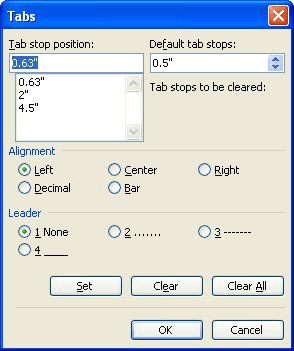Please Note: This article is written for users of the following Microsoft Word versions: 97, 2000, 2002, and 2003. If you are using a later version (Word 2007 or later), this tip may not work for you. For a version of this tip written specifically for later versions of Word, click here: Vertical Lines in Word.
Written by Allen Wyatt (last updated April 23, 2022)
This tip applies to Word 97, 2000, 2002, and 2003
For some documents you may have a need to insert vertical lines. There are actually three or four different ways you can do this in Word. The actual method you choose depends on your document needs and which appeals to you the most. The first method involves using the Drawing toolbar:
You can continue to draw more lines using this same technique, or you can simply close the drawing toolbar by again clicking on the Drawing tool on the regular toolbar.
The second method involves using bar tab stops. You can see how these appear by following these steps:

Figure 1. The Tabs dialog box.
If you have multiple columns in your document and you want vertical lines between the columns, you can follow these steps:

Figure 2. The Columns dialog box.
The final way to create vertical lines is to use tables. While this may seem a bit convoluted, it will work great for small sections of text. To use this method, follow these general steps:
WordTips is your source for cost-effective Microsoft Word training. (Microsoft Word is the most popular word processing software in the world.) This tip (1061) applies to Microsoft Word 97, 2000, 2002, and 2003. You can find a version of this tip for the ribbon interface of Word (Word 2007 and later) here: Vertical Lines in Word.

Create Custom Apps with VBA! Discover how to extend the capabilities of Office 365 applications with VBA programming. Written in clear terms and understandable language, the book includes systematic tutorials and contains both intermediate and advanced content for experienced VB developers. Designed to be comprehensive, the book addresses not just one Office application, but the entire Office suite. Check out Mastering VBA for Microsoft Office 365 today!
Adding graphics to your documents can make them livelier and easier to understand. What if you can't select and edit the ...
Discover MorePlace enough pictures, and sooner or later you start wondering if there is a way to set up some default settings for ...
Discover MoreIf you need to move a graphic just a little bit in one direction or another, you can do so by using the techniques in ...
Discover MoreFREE SERVICE: Get tips like this every week in WordTips, a free productivity newsletter. Enter your address and click "Subscribe."
There are currently no comments for this tip. (Be the first to leave your comment—just use the simple form above!)
Got a version of Word that uses the menu interface (Word 97, Word 2000, Word 2002, or Word 2003)? This site is for you! If you use a later version of Word, visit our WordTips site focusing on the ribbon interface.
Visit the WordTips channel on YouTube
FREE SERVICE: Get tips like this every week in WordTips, a free productivity newsletter. Enter your address and click "Subscribe."
Copyright © 2025 Sharon Parq Associates, Inc.
Comments